Abstract
1. We have compared the potency of the putative platelet-activating factor (Paf) receptor antagonists (WEB 2086, L-652,731 and BN 52021) against Paf-induced aggregation of rabbit and guinea-pig platelets, aggregation of rabbit polymorphonuclear leukocytes (PMNLs) and prostacyclin generation by guinea-pig resident peritoneal macrophages. 2. On rabbit washed platelets and PMNLs WEB 2086, L-652,731 and BN 52021 each antagonized competitively Paf-induced aggregation. The rank order of potency was WEB 2086 congruent to L-652,731 greater than BN 52021 and was the same for the two cell types. 3. The pA2 values for each of the three antagonists were similar on rabbit washed platelets and PMNLs. Moreover, the pA2 for WEB 2086 on rabbit platelets (7.58) did not differ significantly from that on guinea-pig platelets (7.69). 4. On guinea-pig resident peritoneal macrophages WEB 2086 was 10 fold less potent for receptors mediating increased generation of 6-oxo-prostaglandin F1 alpha (6-oxo-PGF1 alpha) than for those mediating platelet aggregation. 5. The potencies of L-652,731 and BN 52021 were also markedly less (2 log units) for the macrophage receptors than for platelet or PMNL receptors and BN 52021 was more potent than L-652,731 in the macrophages. 6. WEB 2086 and L-652,731 significantly reduced basal 6-oxo-PGF1 alpha produced by macrophages, but none of the antagonists affected 6-oxo-PGF1 alpha production during stimulation by A23187. 7. These data raise the possibility that there may be a Paf receptor-subtype mediating prostacyclin generation in macrophages that is different from that on the platelet and PMNL.(ABSTRACT TRUNCATED AT 250 WORDS)
Full text
PDF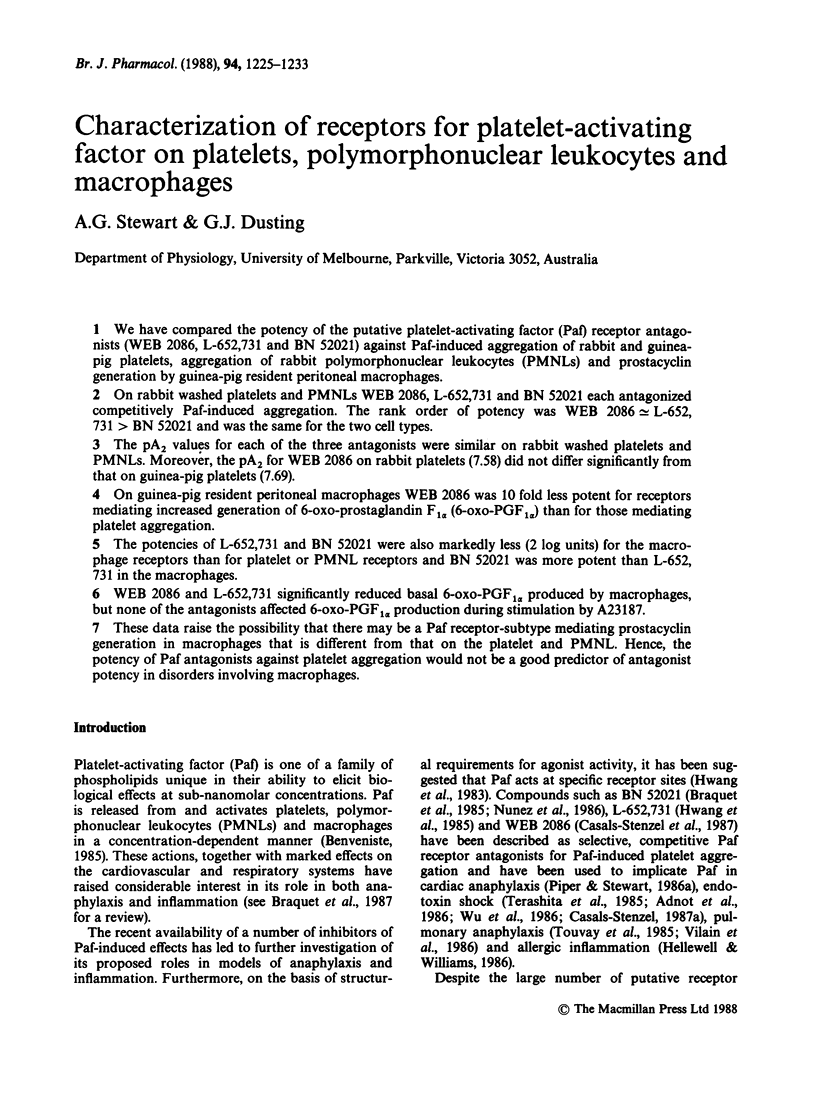
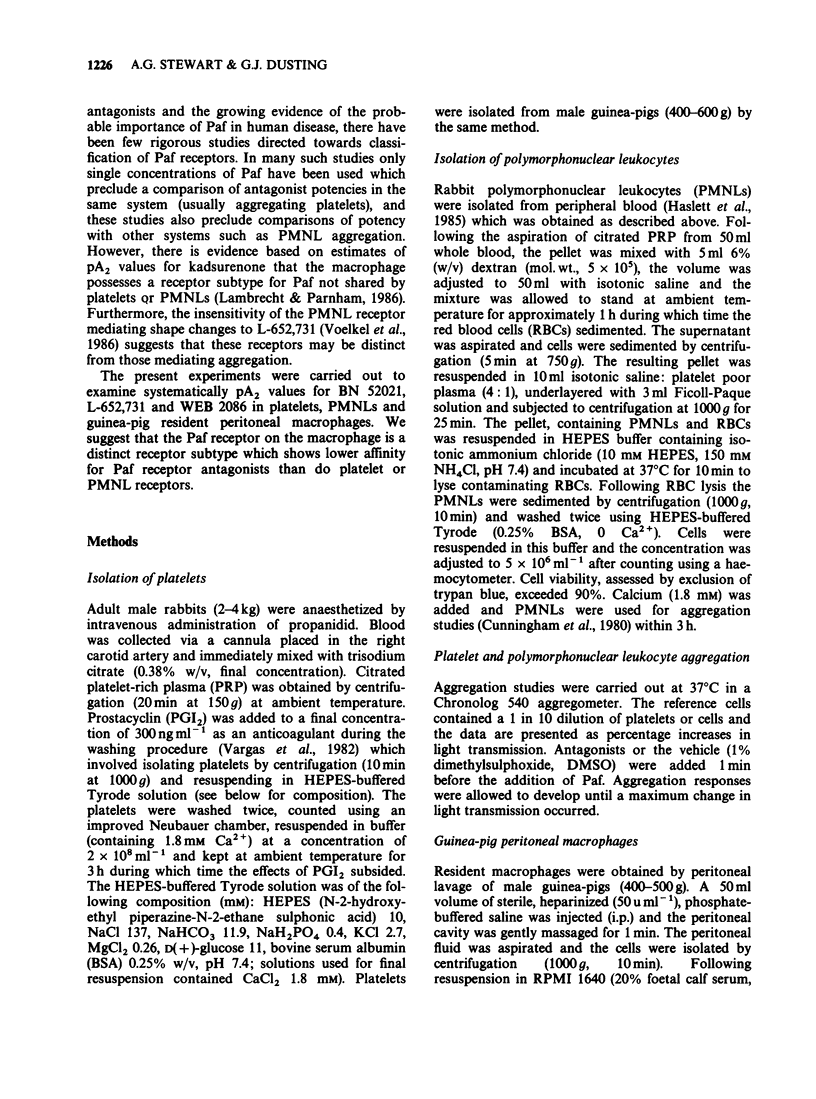
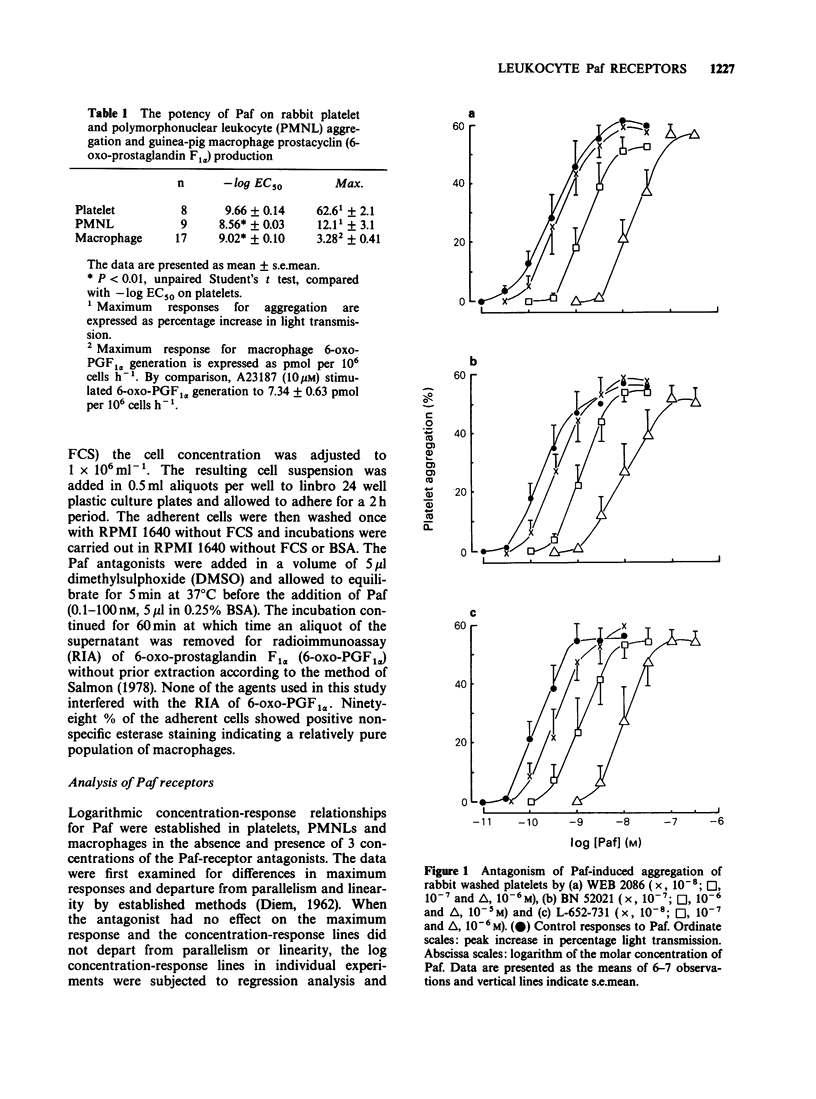
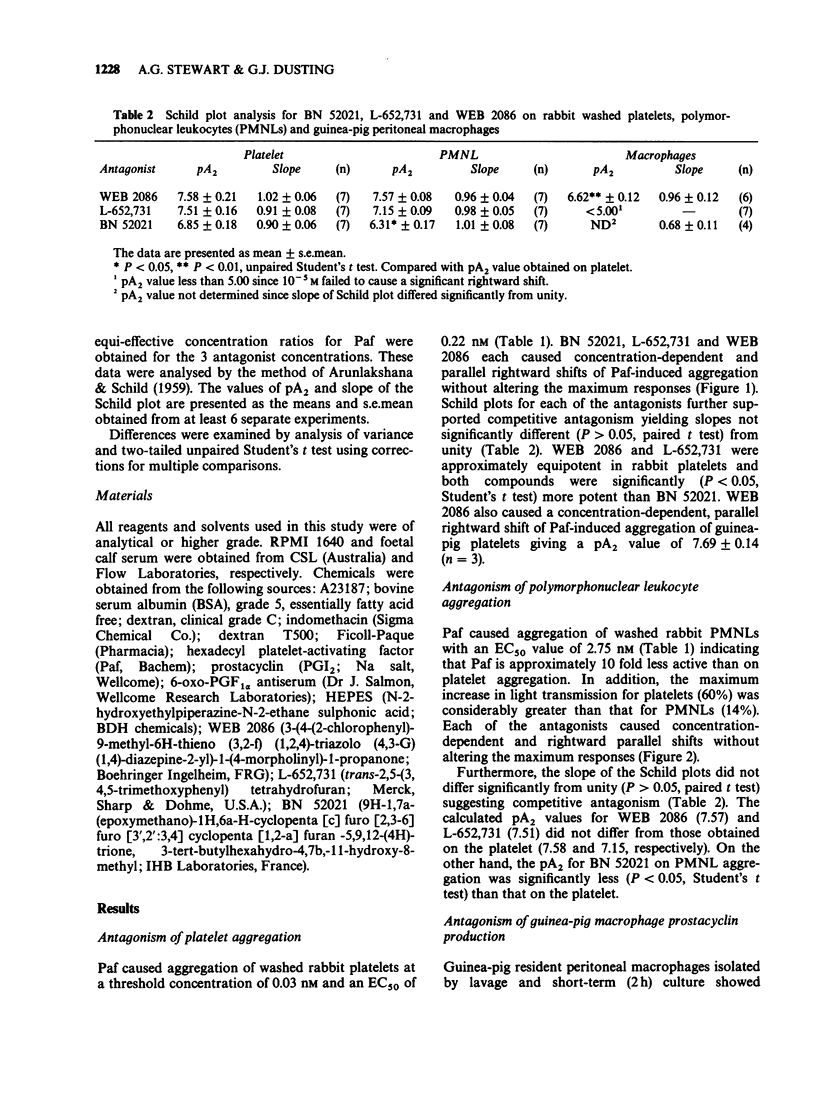
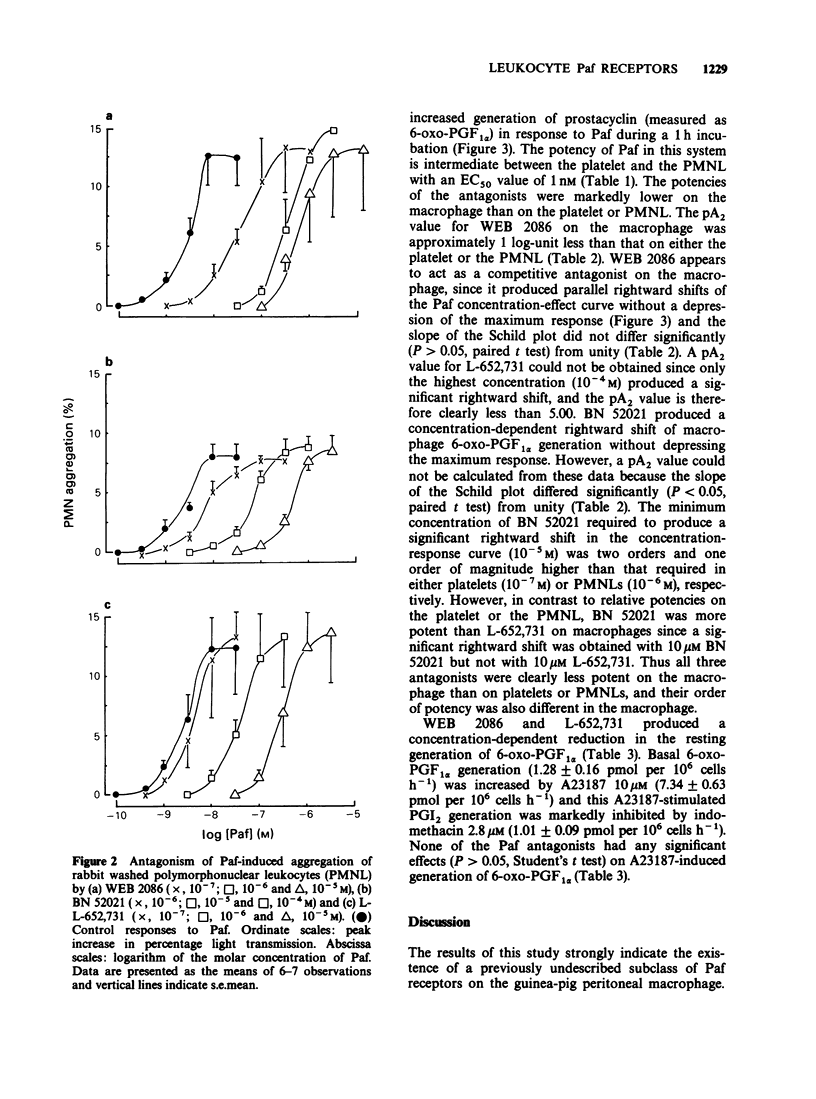
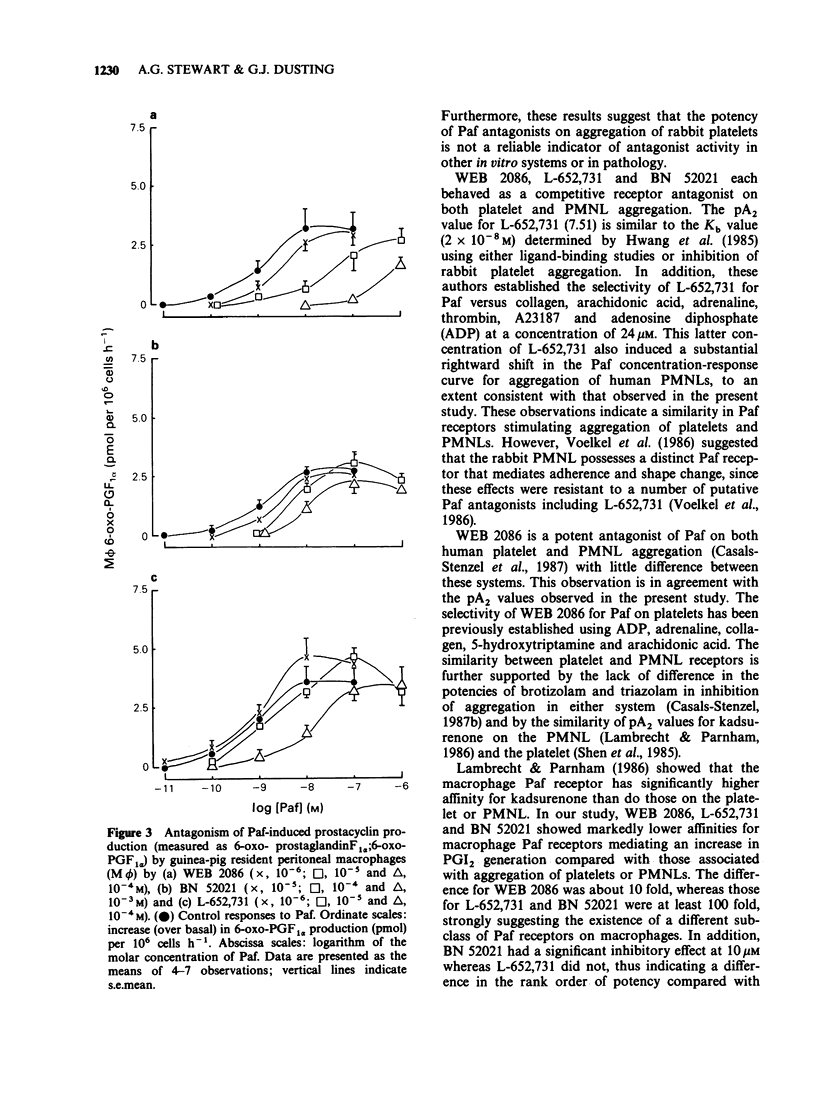
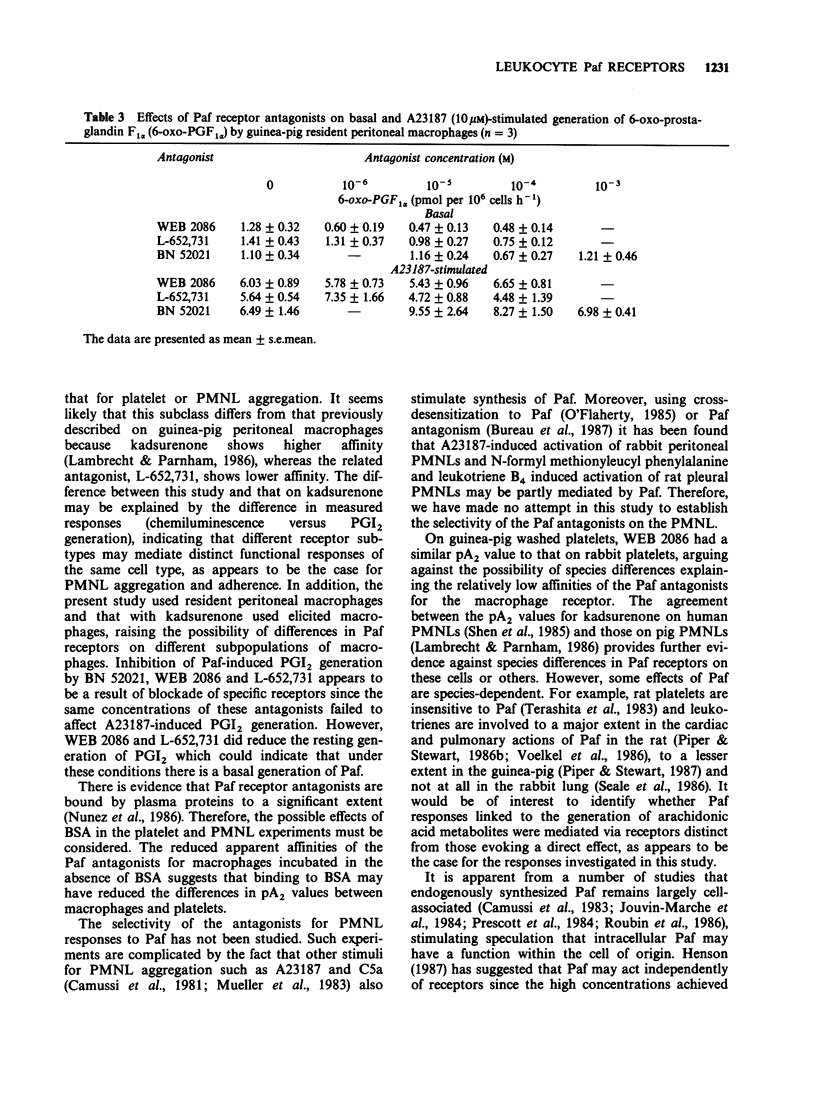
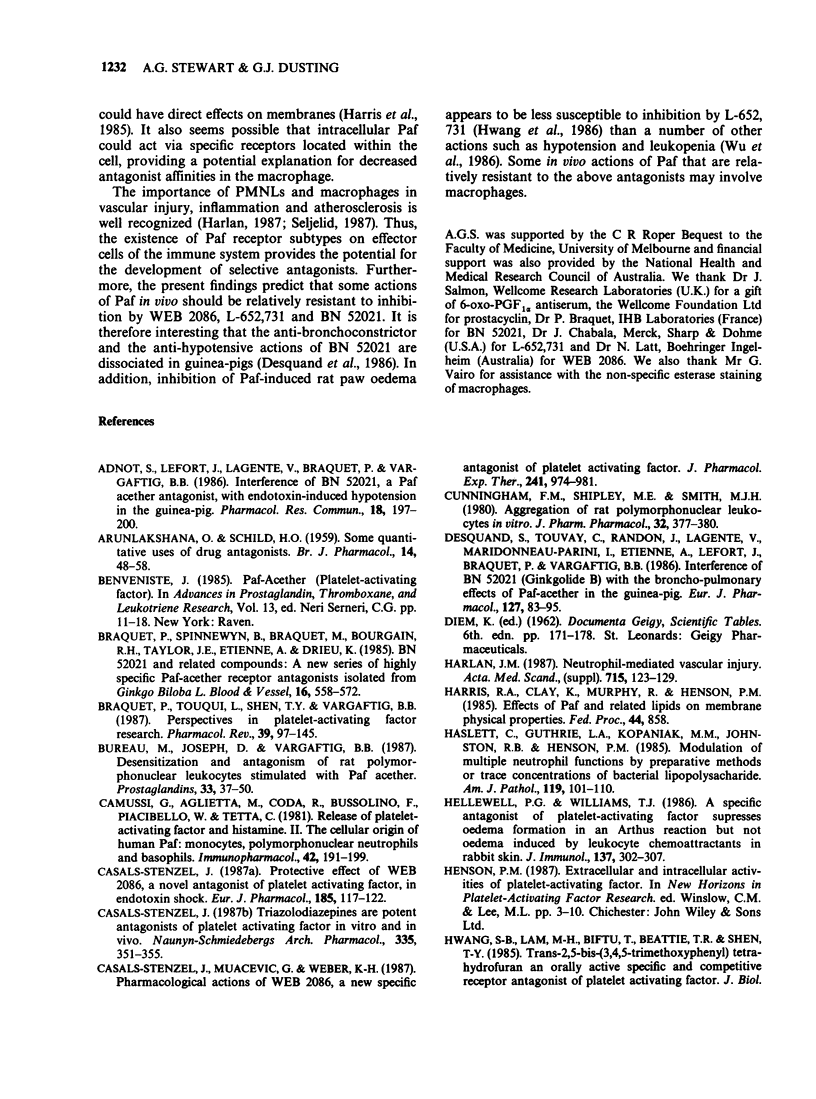
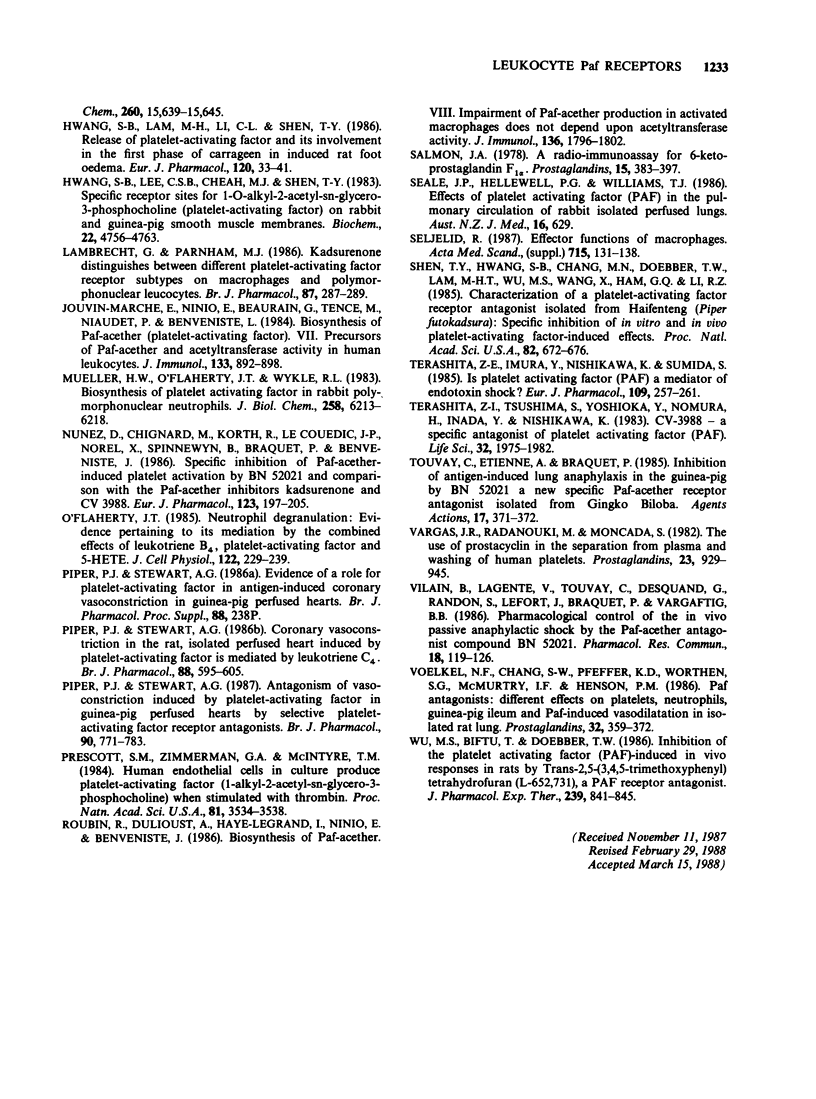
Selected References
These references are in PubMed. This may not be the complete list of references from this article.
- ARUNLAKSHANA O., SCHILD H. O. Some quantitative uses of drug antagonists. Br J Pharmacol Chemother. 1959 Mar;14(1):48–58. doi: 10.1111/j.1476-5381.1959.tb00928.x. [DOI] [PMC free article] [PubMed] [Google Scholar]
- Adnot S., Lefort J., Lagente V., Braquet P., Vargaftig B. B. Interference of BN 52021, a PAF-acether antagonist, with endotoxin-induced hypotension in the guinea-pig. Pharmacol Res Commun. 1986 Aug;18 (Suppl):197–200. doi: 10.1016/0031-6989(86)90052-4. [DOI] [PubMed] [Google Scholar]
- Benveniste J. Paf-acether (platelet-activating factor). Adv Prostaglandin Thromboxane Leukot Res. 1985;13:11–18. [PubMed] [Google Scholar]
- Braquet P., Touqui L., Shen T. Y., Vargaftig B. B. Perspectives in platelet-activating factor research. Pharmacol Rev. 1987 Jun;39(2):97–145. [PubMed] [Google Scholar]
- Bureau M., Joseph D., Vargaftig B. B. Desensitization and antagonism of rat polymorphonuclear leukocytes stimulated with PAF acether. Prostaglandins. 1987 Jan;33(1):37–50. doi: 10.1016/0090-6980(87)90303-0. [DOI] [PubMed] [Google Scholar]
- Camussi G., Aglietta M., Coda R., Bussolino F., Piacibello W., Tetta C. Release of platelet-activating factor (PAF) and histamine. II. The cellular origin of human PAF: monocytes, polymorphonuclear neutrophils and basophils. Immunology. 1981 Feb;42(2):191–199. [PMC free article] [PubMed] [Google Scholar]
- Casals-Stenzel J., Muacevic G., Weber K. H. Pharmacological actions of WEB 2086, a new specific antagonist of platelet activating factor. J Pharmacol Exp Ther. 1987 Jun;241(3):974–981. [PubMed] [Google Scholar]
- Casals-Stenzel J. Protective effect of WEB 2086, a novel antagonist of platelet activating factor, in endotoxin shock. Eur J Pharmacol. 1987 Mar 17;135(2):117–122. doi: 10.1016/0014-2999(87)90602-9. [DOI] [PubMed] [Google Scholar]
- Casals-Stenzel J. Triazolodiazepines are potent antagonists of platelet activating factor (PAF) in vitro and in vivo. Naunyn Schmiedebergs Arch Pharmacol. 1987 Mar;335(3):351–355. doi: 10.1007/BF00172810. [DOI] [PubMed] [Google Scholar]
- Cunningham F. M., Shipley M. E., Smith M. J. Aggregation of rat polymorphonuclear leucocytes in vitro. J Pharm Pharmacol. 1980 May;32(5):377–380. doi: 10.1111/j.2042-7158.1980.tb12946.x. [DOI] [PubMed] [Google Scholar]
- Desquand S., Touvay C., Randon J., Lagente V., Vilain B., Maridonneau-Parini I., Etienne A., Lefort J., Braquet P., Vargaftig B. B. Interference of BN 52021 (ginkgolide B) with the bronchopulmonary effects of PAF-acether in the guinea-pig. Eur J Pharmacol. 1986 Aug 7;127(1-2):83–95. doi: 10.1016/0014-2999(86)90208-6. [DOI] [PubMed] [Google Scholar]
- Harlan J. M. Neutrophil-mediated vascular injury. Acta Med Scand Suppl. 1987;715:123–129. doi: 10.1111/j.0954-6820.1987.tb09912.x. [DOI] [PubMed] [Google Scholar]
- Haslett C., Guthrie L. A., Kopaniak M. M., Johnston R. B., Jr, Henson P. M. Modulation of multiple neutrophil functions by preparative methods or trace concentrations of bacterial lipopolysaccharide. Am J Pathol. 1985 Apr;119(1):101–110. [PMC free article] [PubMed] [Google Scholar]
- Hellewell P. G., Williams T. J. A specific antagonist of platelet-activating factor suppresses oedema formation in an Arthus reaction but not oedema induced by leukocyte chemoattractants in rabbit skin. J Immunol. 1986 Jul 1;137(1):302–307. [PubMed] [Google Scholar]
- Hwang S. B., Lam M. H., Li C. L., Shen T. Y. Release of platelet activating factor and its involvement in the first phase of carrageenin-induced rat foot edema. Eur J Pharmacol. 1986 Jan 14;120(1):33–41. doi: 10.1016/0014-2999(86)90636-9. [DOI] [PubMed] [Google Scholar]
- Jouvin-Marche E., Ninio E., Beaurain G., Tence M., Niaudet P., Benveniste J. Biosynthesis of Paf-acether (platelet-activating factor). VII. Precursors of Paf-acether and acetyl-transferase activity in human leukocytes. J Immunol. 1984 Aug;133(2):892–898. [PubMed] [Google Scholar]
- Lambrecht G., Parnham M. J. Kadsurenone distinguishes between different platelet activating factor receptor subtypes on macrophages and polymorphonuclear leucocytes. Br J Pharmacol. 1986 Feb;87(2):287–289. doi: 10.1111/j.1476-5381.1986.tb10816.x. [DOI] [PMC free article] [PubMed] [Google Scholar]
- Mueller H. W., O'Flaherty J. T., Wykle R. L. Biosynthesis of platelet activating factor in rabbit polymorphonuclear neutrophils. J Biol Chem. 1983 May 25;258(10):6213–6218. [PubMed] [Google Scholar]
- Nunez D., Chignard M., Korth R., Le Couedic J. P., Norel X., Spinnewyn B., Braquet P., Benveniste J. Specific inhibition of PAF-acether-induced platelet activation by BN 52021 and comparison with the PAF-acether inhibitors kadsurenone and CV 3988. Eur J Pharmacol. 1986 Apr 16;123(2):197–205. doi: 10.1016/0014-2999(86)90660-6. [DOI] [PubMed] [Google Scholar]
- O'Flaherty J. T. Neutrophil degranulation: evidence pertaining to its mediation by the combined effects of leukotriene B4, platelet-activating factor, and 5-HETE. J Cell Physiol. 1985 Feb;122(2):229–239. doi: 10.1002/jcp.1041220211. [DOI] [PubMed] [Google Scholar]
- Piper P. J., Stewart A. G. Antagonism of vasoconstriction induced by platelet-activating factor in guinea-pig perfused hearts by selective platelet-activating factor receptor antagonists. Br J Pharmacol. 1987 Apr;90(4):771–783. doi: 10.1111/j.1476-5381.1987.tb11231.x. [DOI] [PMC free article] [PubMed] [Google Scholar]
- Piper P. J., Stewart A. G. Coronary vasoconstriction in the rat, isolated perfused heart induced by platelet-activating factor is mediated by leukotriene C4. Br J Pharmacol. 1986 Jul;88(3):595–605. doi: 10.1111/j.1476-5381.1986.tb10240.x. [DOI] [PMC free article] [PubMed] [Google Scholar]
- Prescott S. M., Zimmerman G. A., McIntyre T. M. Human endothelial cells in culture produce platelet-activating factor (1-alkyl-2-acetyl-sn-glycero-3-phosphocholine) when stimulated with thrombin. Proc Natl Acad Sci U S A. 1984 Jun;81(11):3534–3538. doi: 10.1073/pnas.81.11.3534. [DOI] [PMC free article] [PubMed] [Google Scholar]
- Roubin R., Dulioust A., Haye-Legrand I., Ninio E., Benveniste J. Biosynthesis of paf-acether: VIII: Impairment of paf-acether production in activated macrophages does not depend upon acetyltransferase activity. J Immunol. 1986 Mar 1;136(5):1796–1802. [PubMed] [Google Scholar]
- Salmon J. A. A radioimmunoassay for 6-keto-prostaglandin F1alpha. Prostaglandins. 1978 Mar;15(3):383–397. doi: 10.1016/0090-6980(78)90122-3. [DOI] [PubMed] [Google Scholar]
- Seljelid R. Effector functions of macrophages. Acta Med Scand Suppl. 1987;715:131–138. doi: 10.1111/j.0954-6820.1987.tb09913.x. [DOI] [PubMed] [Google Scholar]
- Shen T. Y., Hwang S. B., Chang M. N., Doebber T. W., Lam M. H., Wu M. S., Wang X., Han G. Q., Li R. Z. Characterization of a platelet-activating factor receptor antagonist isolated from haifenteng (Piper futokadsura): specific inhibition of in vitro and in vivo platelet-activating factor-induced effects. Proc Natl Acad Sci U S A. 1985 Feb;82(3):672–676. doi: 10.1073/pnas.82.3.672. [DOI] [PMC free article] [PubMed] [Google Scholar]
- Terashita Z., Imura Y., Nishikawa K., Sumida S. Is platelet activating factor (PAF) a mediator of endotoxin shock? Eur J Pharmacol. 1985 Feb 26;109(2):257–261. doi: 10.1016/0014-2999(85)90427-3. [DOI] [PubMed] [Google Scholar]
- Terashita Z., Tsushima S., Yoshioka Y., Nomura H., Inada Y., Nishikawa K. CV-3988 - a specific antagonist of platelet activating factor (PAF). Life Sci. 1983 Apr 25;32(17):1975–1982. doi: 10.1016/0024-3205(83)90049-8. [DOI] [PubMed] [Google Scholar]
- Touvay C., Etienne A., Braquet P. Inhibition of antigen-induced lung anaphylaxis in the guinea-pig by BN 52021 a new specific paf-acether receptor antagonist isolated from Ginkgo biloba. Agents Actions. 1986 Jan;17(3-4):371–372. doi: 10.1007/BF01982650. [DOI] [PubMed] [Google Scholar]
- Vargas J. R., Radomski M., Moncada S. The use of prostacyclin in the separation from plasma and washing of human platelets. Prostaglandins. 1982 Jun;23(6):929–945. doi: 10.1016/0090-6980(82)90135-6. [DOI] [PubMed] [Google Scholar]
- Vilain B., Lagente V., Touvay C., Desquand S., Randon J., Lefort J., Braquet P., Vargaftig B. B. Pharmacological control of the in vivo passive anaphylactic shock by the PAF-acether antagonist compound BN 52021. Pharmacol Res Commun. 1986 Aug;18 (Suppl):119–126. doi: 10.1016/0031-6989(86)90044-5. [DOI] [PubMed] [Google Scholar]
- Voelkel N. F., Chang S. W., Pfeffer K. D., Worthen S. G., McMurtry I. F., Henson P. M. PAF antagonists: different effects on platelets, neutrophils, guinea pig ileum and PAF-induced vasodilation in isolated rat lung. Prostaglandins. 1986 Sep;32(3):359–372. doi: 10.1016/0090-6980(86)90005-5. [DOI] [PubMed] [Google Scholar]
- Wu M. S., Biftu T., Doebber T. W. Inhibition of the platelet activating factor (PAF)-induced in vivo responses in rats by trans-2,5-(3,4,5-trimethoxyphenyl) tetrahydrofuran (L-652,731), a PAF receptor antagonist. J Pharmacol Exp Ther. 1986 Dec;239(3):841–845. [PubMed] [Google Scholar]


